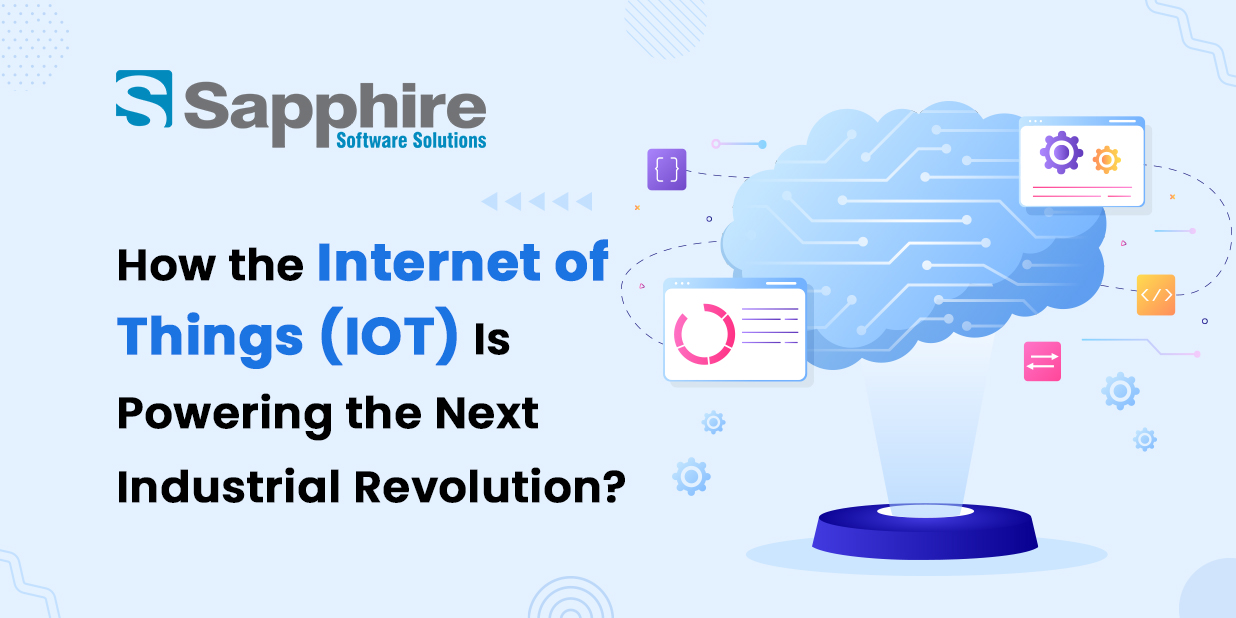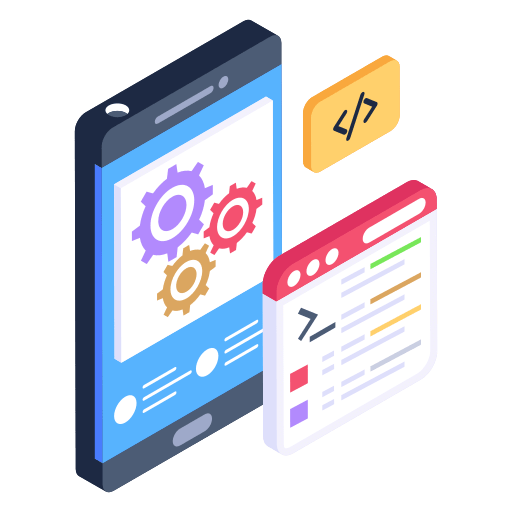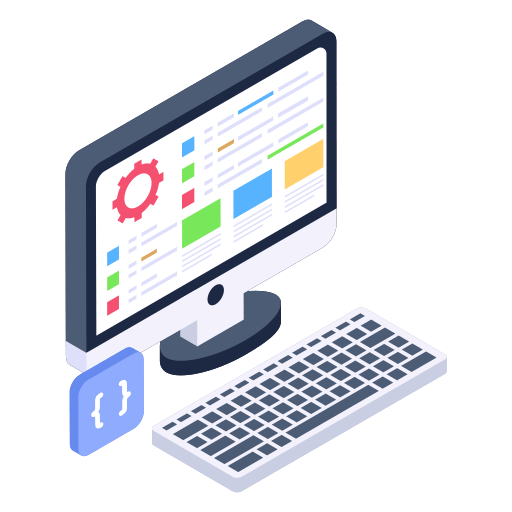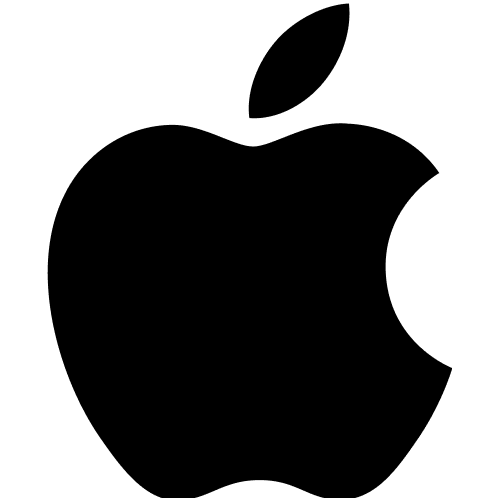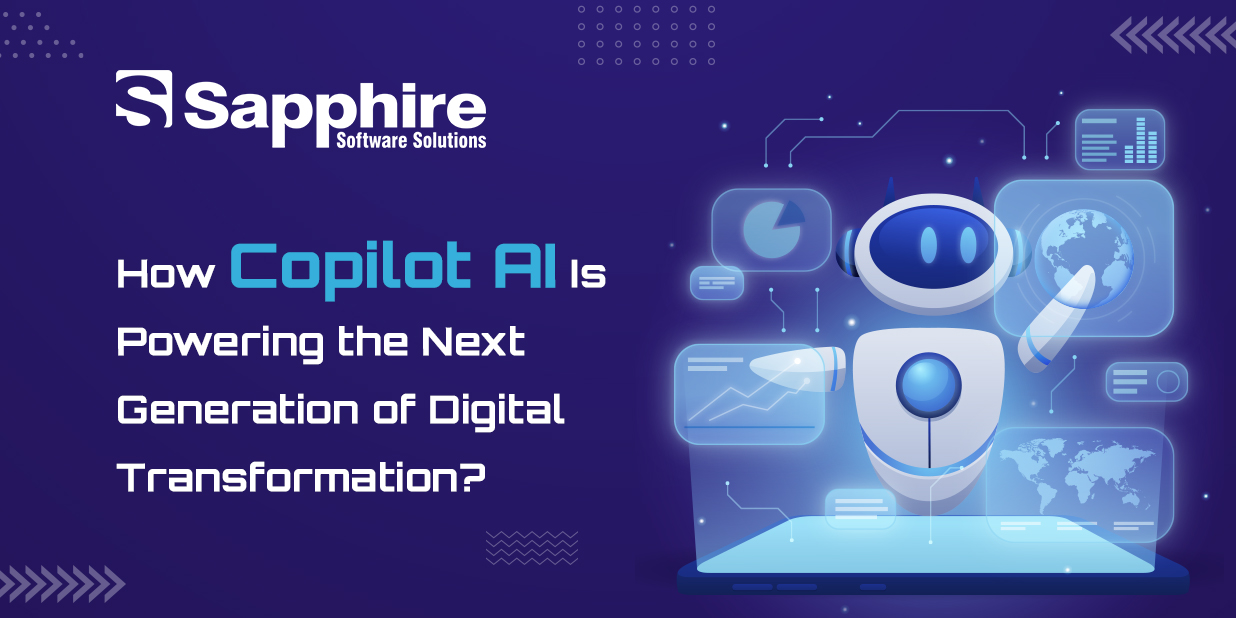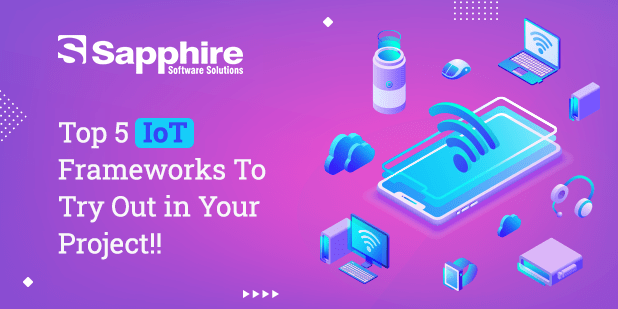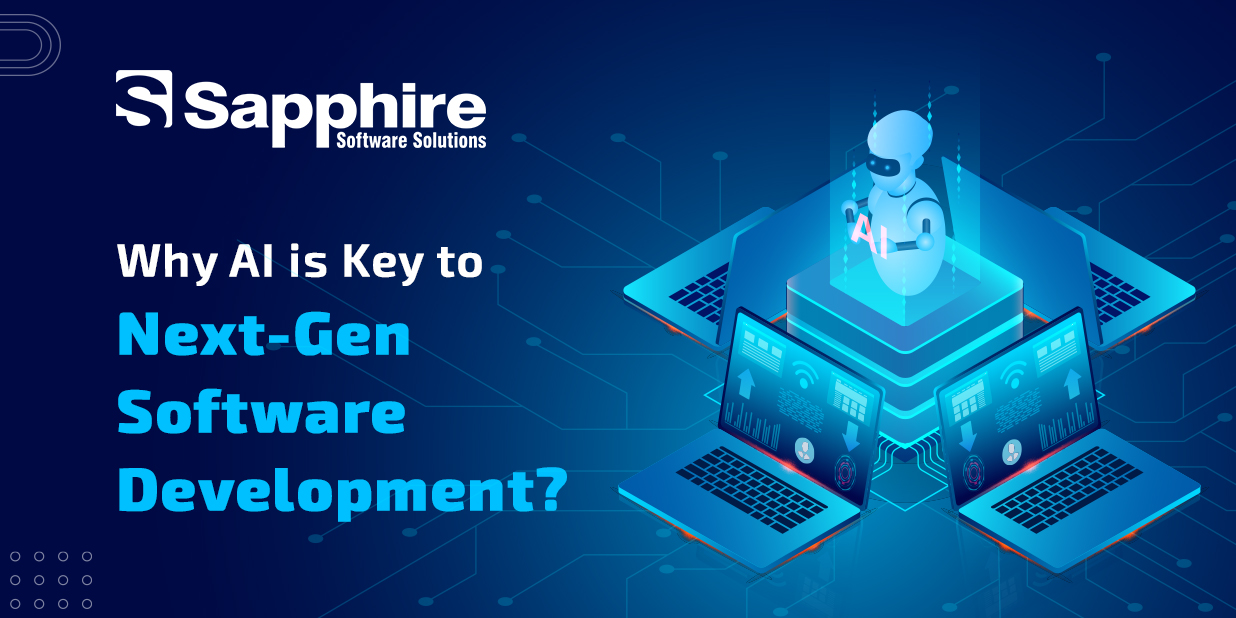The Internet of Things (IoT) is insidiously changing the way we are connected to the world around us. Fundamentally, IoT describes an enormous network of devices that are communicating and exchanging data, turning ordinary objects into intelligent, responsive systems. From intelligent thermostats to industrial sensors, these devices talk and act without human intervention, resulting in increased efficiency, intelligent resource management, and new business models.
Why it matters:
- Ubiquity: Ordinary objects—your refrigerator, security camera, or even streetlight—can be integrated into a smart environment.
- Automation & Intelligence: Sensors capture real-time information; analytics and AI subsequently translate that information to maximize systems, eliminate waste, and anticipate needs.
- Workflow Agility: IoT allows companies to remain agile, nimbly adapting to market fluctuations, enhancing uptime, and crafting data-forged products.
Challenges to highlight: Data privacy, Internet of Things Security, and system interoperability are key concerns. Providing a sound Internet of Things Architecture and secure data management should be a priority to build trust and keep pace with regulations such as GDPR and HIPAA.
What are Internet of Things Devices?
Internet of Things Devices are tangible objects that have sensors, software, and connectivity capabilities embedded in them, which allow them to capture and share data via the internet or other networks. The devices are the backbone of the Internet of Things (IoT) environment, allowing for real-time intelligence, automation, and intelligent decision-making within thousands of industries.
All these devices differ in complexity—ranging from basic temperature sensors to advanced autonomous vehicles—but they all work toward one thing: linking the physical and digital domains. For instance, a smart thermostat can sense room occupation and adjust temperatures accordingly, while an industrial vibration sensor can notify engineers when equipment failure is imminent.
IoT devices are generally classified into a limited number of primary groups:
1. Consumer Devices:
These comprise smart home devices such as thermostats, lighting, fitness trackers, smartwatches, and voice assistants. They enhance user convenience, security, and lifestyle customization.
2. Industrial Devices:
Referred to as Industrial IoT (IIoT), these devices track production lines, machine health, and environmental conditions in manufacturing, oil & gas, and logistics. They play a pivotal role in predictive maintenance and operational effectiveness.
3. Medical Devices:
With the Internet of Things in Healthcare, innovations such as wearable ECG monitors, glucose monitoring implants, and remote diagnostic devices transform patient care and management of chronic diseases.
4. Agricultural Devices:
Farmers now use Internet of Things Devices such as soil moisture sensors, drone imaging systems, and automated irrigation controllers to increase yields and save resources through data farming.
Some of the essential features of IoT devices are real-time sensing, self-sufficient decision-making, remote monitoring, and ubiquitous integration into larger Internet of Things Architecture systems. They also focus on Internet of Things Security since they manage sensitive or mission-critical information.
From smart home refrigerators to citywide AI-enabled surveillance systems, Internet of Things Devices are at the core of the IoT phenomenon—enabling an interconnected world where things react smartly to our requirements, environments, and objectives.
How Does the Internet of Things Work?
The Internet of Things (IoT) functions through the interconnection of physical devices—likewise Internet of Things Devices—to the internet, so they can gather, share, and process data in real time. The devices contain sensors, processors, and communication technology that enable them to capture environmental conditions and perform smart actions depending on the information they gather or create. But what makes this whole system effective is the effortless integration of hardware, software, network communication, and data analytics—all aspects of the Internet of Things Architecture.
Fundamentally, IoT works in four main stages:
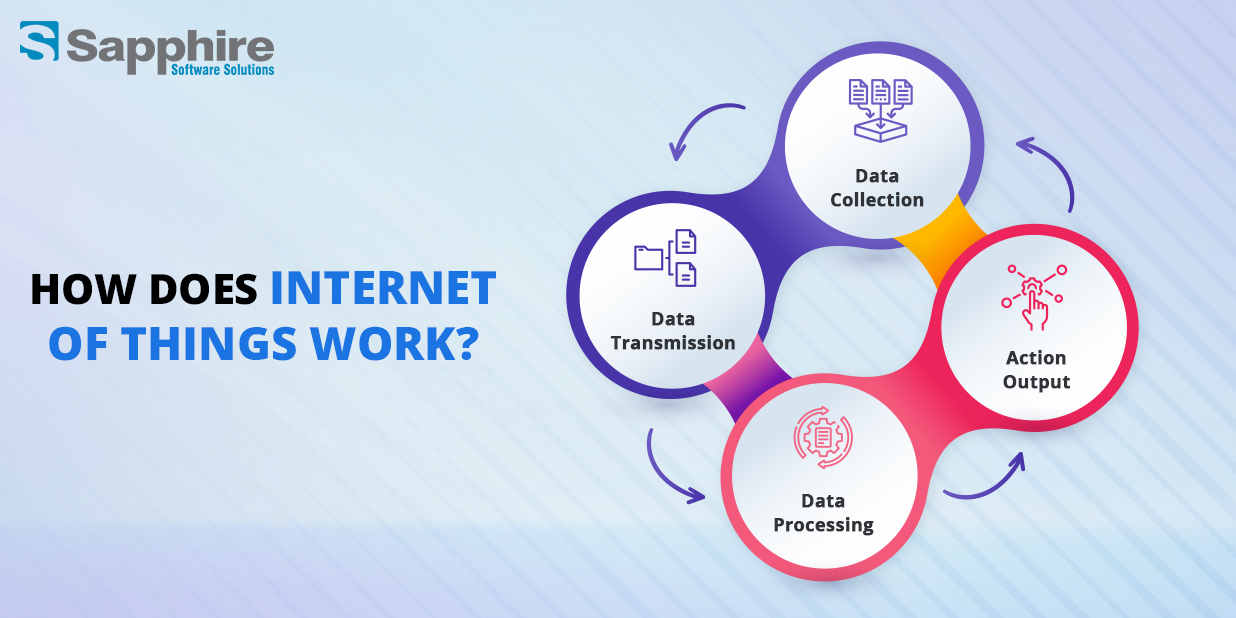
1. Data Collection (Perception Layer):
This layer is made up of some range of IoT devices—like smart thermostats, fitness trackers, and industrial sensors—that capture data from their surroundings. These may include temperature, motion, humidity, heart rate, light, and so on.
2. Data Transmission (Network Layer):
The data, once gathered, is then sent to a central platform (usually in the cloud) via Internet of Things Technology like Wi-Fi, Bluetooth, Zigbee, or cellular networks.
3. Data Processing (Middleware Layer):
In this layer, high-end servers, cloud infrastructure, and edge computing nodes process the incoming data. With machine learning algorithms or fixed logic, the system analyzes the data and determines if an action needs to be performed.
4. Action/Output (Application Layer):
This is what users see—IoT’s visible component: smart apps, dashboards, and notifications. The information received from processing is displayed to end users in the form of applications, allowing them to react or letting the system react on their behalf.
Internet of Things Security is important at all stages to safeguard data integrity and user privacy. End-to-end encryption, secure APIs, and continuous vulnerability scanning are a must for the safe operation of IoT ecosystems.
Be it Internet of Things in Agriculture tracking the health of soil or Internet of Things in Healthcare monitoring vital signs, this smart cycle of data sensing, sharing, analyzing, and acting characterizes the way IoT delivers value. This interlinked workflow facilitates Internet of Things Advantages in the form of automation, predictive insights, and efficiency of operation in virtually every industry.
Why is IoT important?
The Internet of Things (IoT) is one of the most disruptive technologies of the 21st century. So, why is IoT crucial? The reason is that it has the power to bridge the physical and digital worlds in a manner that enables our lives to be smarter, more efficient, and data-centric. Through more and more interconnected Internet of Things Devices, IoT enables machines, systems. And even settings to collect and exchange information in real-time, reshaping the way individuals, firms, and industries conduct business.
For businesses, Internet of Things Technology offers record levels of automation and knowledge. Machines are no longer required to wait for directions from humans. With IoT, a malfunctioning factory robot can alert engineers prior to failure, or a networked irrigation system can water crops based on patterns of weather—examples where Internet of Things in Agriculture is maximizing resource optimization and crop yield.
- Internet of Things in Healthcare is facilitating life-saving technology innovations in healthcare. Connected devices like remote patient monitors or smart insulin pens can monitor vital signs or medication use continuously.
- One of the most important Internet of Things Benefits is its capacity for data-driven decision-making. With automated data monitoring and processing via sensors and intelligent devices, companies and individuals can make faster and more reliable decisions.
- IoT is also critical to sustainability. Smart grids, energy-efficient devices, and smart traffic systems—powered by Internet of Things Architecture—mitigate energy consumption and carbon emissions.
- Security is the prime imperative, and that is where Internet of Things Security comes in. With more and more devices being networked and exchanging information, there must be security both at the communication channels and at the level of the devices themselves to protect that trust with the user.
- Finally, the value of IoT isn’t about devices and data—it’s about changing how we work and live. From smart cities to smart agriculture, and precision medicine to predictive maintenance, IoT is the backbone of tomorrow’s smart ecosystem. That’s why it’s no longer a choice; IoT adoption is now a strategic imperative.
What Technologies have made IoT possible?
The Internet of Things has not suddenly emerged overnight; it is the coming together of several advanced technologies to enable real-time information sharing, intelligent automation, and cross-device communication. For the most part, IoT Technology runs on connectivity, computing, and data science. But what specific innovations have realized the vision of a smart, connected world?
First and foremost, cheap and efficient sensors. Such small yet powerful devices are embedded in a broad array of Internet of Things Devices—from health monitors and smart thermostats to industrial machines. They collect continuous streams of data on the environment, such as temperature, pressure, and motion. No sensors—no IoT.
The second enabling technology is wireless connectivity. Due to technological advancements in 4G, 5G, Wi-Fi 6, Bluetooth Low Energy (BLE), Zigbee, and LoRaWAN, devices from diverse geographies can remain connected and pass data without any issues. This layer of connectivity is the backbone of the Internet of Things Architecture and connects everything in an intelligent system.
Also pivotal is the development of machine learning and artificial intelligence (AI). These technologies enable Internet of Things Devices to understand large data sets, identify patterns, and make real-time decisions. This is particularly useful in predictive maintenance, intelligent healthcare, and personalized user experience.
All these technologies—connectivity, hardware, software, and intelligence—function in concert to build a dynamic, secure, and scalable Internet of Things System. They make the connected world we depend on today possible.
What are the benefits of the Internet of Things for Business?
- Internet of Things is revolutionizing businesses in the way they operate, innovate, and compete for customer share. From smart-manufacturing floors to intelligent shelf management in their retails, the benefits of Internet of Things for business go beyond convenience; it redefines productivity, reduces operational costs, and unlocks new revenue streams.
- Making business practices have real-time data collection and analysis. Through connected sensors and devices, companies can monitor processes in real time—be it in supply chains, logistics, or customer service. Such internet of things devices transmits critical information, such as temperature, inventory levels, equipment status, and customer preferences, so businesses can act at once, strategically.
- Energy consumption is also massively optimized. Through smart lighting, HVAC systems, and IoT-enabled energy meters, companies can cut waste and optimize energy use. This does not merely lower costs; it supports corporate sustainability objectives, which are increasingly important in today’s socially conscious economy.
- The Internet of Things also benefits customer experience. Businesses using IoT App Development Services can provide hyper-personalized interactions, such as product recommendations based on browsing or buying behaviors. Retailers, for example, can leverage beacons to push offers to customers as they move through aisles, enhancing engagement and converting sales better.
- Finally, businesses benefit from enhanced asset tracking and automated operations. Whether it’s fleet management or inventory control, the Internet of Things Architecture ensures everything is tracked in real-time, reducing human error and increasing transparency.
Examples of Internet of Things Applications:
Internet of Things (IoT) has transformed industries in general by providing more intelligent, real-time interconnectivity between devices, data, and people. Applications are used today in almost every area, ranging from homes and cities to agriculture, manufacturing, and healthcare. These devices’ powerful, transformative impact on making our environments smarter and more efficient can be better understood through these practical examples.
In smart homes, IoT is an everyday presence. Smart thermostats, lighting systems, door locks, and voice-controlled assistants (you know, Alexa or Google Home) give homeowners an unprecedented level of control and automation. These networked systems don’t just bring convenience but also maximize energy efficiency and provide increased security—traditional Internet of Things Benefits working in everyday life.
In medicine, the Internet of Things in Healthcare solutions has proliferated in relevance with the advent of remote care. Intelligent wearables such as cardiac monitors, blood glucose monitors, and fitness trackers transmit live health information to medical experts, facilitating enhanced monitoring and timely intervention.
Internet of Things in Farming is assisting farmers to raise productivity while saving resources. Intelligent irrigation systems utilize sensors to detect soil moisture and weather patterns, adjusting water flow automatically. Livestock monitoring equipment monitors animals’ health and mobility, allowing for timely interventions. These Internet of Things Applications facilitate sustainable farming practices while delivering maximum yields.
In manufacturing, Industrial IoT is streamlining production lines and supply chains. Machinery sensors give insights into performance and alert the teams to maintenance that is required before a breakdown. This enhances efficiency in operations and reduces the expensive downtimes.
How to Select the Right IoT App Development Company for Your Project?
Selecting the best IoT App Development Company is among the most important choices that will lead your Internet of Things project to success. It’s about getting a team that knows your specific industry, has extensive experience working with Internet of Things Architecture, and can provide scalable, secure, and innovative IoT App Development Services that fit your business requirements.
- Request in-depth examples of previous projects, particularly ones that are akin to yours—either it’s Internet of Things in Healthcare, Internet of Things in Agriculture, manufacturing, or smart homes. Experience in the scope and depth of your field can determine if the company is capable of foreseeing potential pitfalls or scaling problems.
- Security is a deal-breaker. Make sure the company has strong Internet of Things Security measures and is aware of the necessity of secure communication between devices, end-to-end encrypted data transfer, and firmware updates. Since IoT usually handles sensitive data—particularly in the healthcare and industrial environments—security must never be an afterthought.
- Also, think about the capacity of the company to grow along with your project. Are they capable of assisting you from proof of concept, MVP, full deployment, to long-term support? An excellent Internet of Things Developer should not only develop their solution but also provide maintenance and optimization services in the long run.
- Finally, assess communication, transparency, and cultural alignment. You’ll be working closely along the lifespan of the project, so make sure they’re responsive, transparent, and share your business objectives. Don’t be afraid to ask for references or speak with previous clients.
Why Choose Sapphire for IoT App Development Services?
In the realm of IoT App Development Services, your choice of partner is not simply a technical decision—it’s a matter of strategic direction, creativity, and dependability. Sapphire Software Solutions is a leading IoT App Development Company with a history of successfully delivering strong, secure, and scalable Internet of Things solutions designed for various industries such as healthcare, agriculture, manufacturing, logistics, and beyond. If you’re looking for a partner that sees both the sophistication and the promise of interlinked ecosystems, Sapphire is the name you can rely on.
- One of the most important reasons to go with Sapphire comes from its profound technical expertise. The organization has been able to successfully work with a range of Internet of Things Devices, from RFID-based sensors and smart meters to industrial controllers and wearables. This hands-on experience enables Sapphire’s developers to craft seamless and intelligent systems that couple hardware with cloud platforms, analytics engines, and mobile interfaces.
- Sapphire also boasts a security-first strategy. With rising data vulnerabilities in IoT ecosystems, the team applies industry-standard protocols in Internet of Things Security, such as encryption, secure APIs, authentication protocols, and recurring penetration testing. For companies handling sensitive data—like Internet of Things in Healthcare or real-time logistics—Sapphire complies with regulations like HIPAA, GDPR, and ISO standards.
- Another significant benefit of selecting Sapphire is cross-industry adaptability. Be it an agriculture wherein Internet of Things will be employed or a retailing biggie optimizing the supply chain by using smart sensors, Sapphire brings the appropriate domain knowledge with innovative solutions. Their portfolio comprises smart irrigation systems, predictive maintenance platforms, telemedicine devices, and AI-integrated inventory management customized using powerful Internet of Things Technology.
- Apart from that, Sapphire also adheres to end-to-end development, managing the entire process from ideation and prototyping to deployment and post-launch care. They have experienced Internet of Things Developers who collaborate with clients in establishing roadmaps, creating seamless user experiences, and utilizing analytics to make improvements repeatedly.
For companies looking for a reliable partner to realize the full Internet of Things Benefits, Sapphire Software Solutions offers results, not promises. It’s not just a development firm—it’s your innovation partner in a hyper-connected world.



















